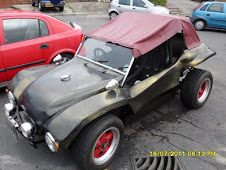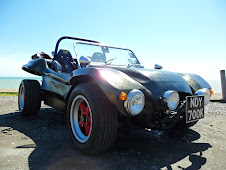 2nd April 2011
2nd April 2011I have to confess most of the week before has been a disaster as I was hopping to have got a lot further on . Having had a bad back and then a horrendous flue like thing. I have not felt like doing much but did manage to eventually do the work i needed to on the bonnet reinforcing its structure in a hope to stop the small paint crack lines that often appear in buggy bonnets.
The real problem I discovered with my bonnet was the thin weight of fibre glass it was made from. I really did not want to layer this up with new fibre glass and decided that I could re-in-force it with hollow channels which were fibre glassed giving it a coating over the top and creating internal strength. This at first seemed quite simple however the space under the bonnet between the tank was quite tight.
 I went to my Glass Fibre polymer supplier and tried to purchase some foam which I felt would work. This however seemed not readily available. Some further investigation took me to B&Q were I managed to buy some cable conduit that was made from PVC. I new this was resistant to the Fibre Glass and started to bond the channels onto the bonnet with Hairy Fibre filler. I cut the ends so that they overlapped the centre of the channel it was meeting against to make a cell structure.
I went to my Glass Fibre polymer supplier and tried to purchase some foam which I felt would work. This however seemed not readily available. Some further investigation took me to B&Q were I managed to buy some cable conduit that was made from PVC. I new this was resistant to the Fibre Glass and started to bond the channels onto the bonnet with Hairy Fibre filler. I cut the ends so that they overlapped the centre of the channel it was meeting against to make a cell structure.  I used heavy objects i found around to press the plastic into the shape of the bonnet this meant it took on the profile snugly. This improved the rigidity of the bonnet immediately. I decided to continue this further round the outside of the bonnet making the whole bonnet structurally stronger.
I used heavy objects i found around to press the plastic into the shape of the bonnet this meant it took on the profile snugly. This improved the rigidity of the bonnet immediately. I decided to continue this further round the outside of the bonnet making the whole bonnet structurally stronger.  With the frame worked glued in I then cut small pieces of Glass 480 mesh to go over the frame and bonded it in position. The completed structure was then cleaned up filling any gaps with Fibre Fill IP48. This then allowed me time to repair the windscreen wiper hole as this had come to large over time. I achieved this by finding a rod the same size as the wind screen wiper shaft and fibre filling this in situ. This was removed just prior to the filler curing. leaving the correct size hole. The area was cleaned up with 600 Glass paper and the whole bonnet area was painted with Black metallic hammerite. Once I had
With the frame worked glued in I then cut small pieces of Glass 480 mesh to go over the frame and bonded it in position. The completed structure was then cleaned up filling any gaps with Fibre Fill IP48. This then allowed me time to repair the windscreen wiper hole as this had come to large over time. I achieved this by finding a rod the same size as the wind screen wiper shaft and fibre filling this in situ. This was removed just prior to the filler curing. leaving the correct size hole. The area was cleaned up with 600 Glass paper and the whole bonnet area was painted with Black metallic hammerite. Once I had  the bonnet painted with hammerite I noticed that the Wind screen motor had a bolt hole to mount it to the bonnet that was not on the bonnet this I felt would also help the reinforcing of the holes as without this securing point the windscreen wiper was hanging from its spindles. I measured that I needed a 40mm block cemented and fibre glassed to the bonnet . I had previously used hidden fastenings on the wings and decided this would be the best method to
the bonnet painted with hammerite I noticed that the Wind screen motor had a bolt hole to mount it to the bonnet that was not on the bonnet this I felt would also help the reinforcing of the holes as without this securing point the windscreen wiper was hanging from its spindles. I measured that I needed a 40mm block cemented and fibre glassed to the bonnet . I had previously used hidden fastenings on the wings and decided this would be the best method to bolt the motor securely to the bonnet. As you can see the block was made from a 40mm x 40mm x 150 mm of oak and this was cemented onto a cleaned area of the bonnet with hairy fibre filler P48 . Once this had dried the whole area was covered with fibre glass and a plate made from a stainless steel piece obtained at a boat chandlers was used to hold a captive nut . This was screed onto the new area and removed for painting. The whole fit was checked before removal for outside body prep.
bolt the motor securely to the bonnet. As you can see the block was made from a 40mm x 40mm x 150 mm of oak and this was cemented onto a cleaned area of the bonnet with hairy fibre filler P48 . Once this had dried the whole area was covered with fibre glass and a plate made from a stainless steel piece obtained at a boat chandlers was used to hold a captive nut . This was screed onto the new area and removed for painting. The whole fit was checked before removal for outside body prep.






















No comments:
Post a Comment